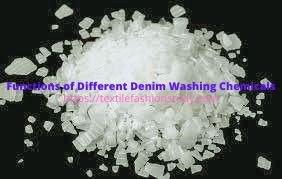Table of Contents
Denim Washing Chemicals
Denim washing chemicals play an important role in enhancing the denim outlook and strength of the denim garment. However, raw denim fabric is sewn into the denim manufacturing garment, and then it is sent to the denim washing plant to add different features through denim washing. It is important to ensure the quality of the denim after washing because if it causes any harm to the human body, then all processes will be wasted. So, the manufacturer should ensure the quality of the garment as well as be concerned about environmental safety.

List of chemicals used in denim washing plants and their functions:
Denim garments are one of the fashions of all ages. However, different types of changes are made to denim garments by the washing process. For this, different types of chemicals are used in different stages of washing. It is important to maintain certain parameters, quantities, and environmental conditions during the washing process. The following chemicals are used for washing denim garments:
- Enzymes
- Anti Backstainer
- Whitening Agent
- Anti Creasing Agent
- Detergents
- Caustic Soda (NaOH)
- Soda Ash (Na2CO3)
- Acetic Acid (CH3COOH)
- Potasium Permanganate (KMnO4)
- Sodium Meta Bi Sulphate (Na2S2O5)
- Sodium Thiosulfate – Hypo (Na2S2O3)
- Hydroxyl Ammonium Sulphate (H8N2O6S)
- Hydrogen Peroxide (H2O2)
- Bleaching Powder – Ca(OCl)Cl, (NaOCl)
- Hygroscopic Agent
- Phosphoric Acid (H3PO4)
- Anti-mildew Agents
- Citric Acid (C6H6O7)
- Softeners
- Leveling Agent
- Optical Brightener
- Resin
- Sequestering Agent
- Stabilizer
- Fixing Agents
- Oxalic Acid
- Rubbing Fastness Improver
- Defoaming Agents
- Biopolish Enzyme
- Weight giving Agent
- Water Proofing Agent
Enzymes:
Enzyme wash is followed by enzymes and gives a worn outlook. Basically, enzymes are biological catalyst that contains polypeptide long chains as they are proteins. However, enzymatic de-sizing is performed to remove the size chemicals as a pre-treatment process of denim washing. It needs a suitable condition to act as a catalyst like a temperature, Ph, the concentration of the solution, and small non-protein molecules as cofactors for some enzymes. It needs to take into mind that, this treatment should be maintained as required and should not be overtreated.
Functions:
- Firstly, enzymes use as cleaning products such as cleaning and fabric care agent.
- Secondly, easily available and cheap so it is mostly used as an alternative to stone washing.
- Thirdly, most of the enzymes break down soils and stains.
- After that, enzymes use to remove hairiness from fabric or garments.
- Then, enzymes speed up the rate of a chemical reaction and remain the same after the reaction.
- Finally, It does not weaken the cellulose fibers instead it makes them softer.
Anti Back Staining Agent
Anti-back staining agent is one of the important denim washing chemicals. However, it is used in washing for pocket cleaning and protects inside weft yarn bleeding. We know that, through an anchor, cellulose enzymes are temporarily bound to cellulose. Basically, it is made available for a further hydrolysis reaction after this process. Consequently, some anti-back staining agents are used in wash baths to avoid this type of back staining. Markedly, anti-back staining agents are capable to restrict actions, where removed dyes are re-deposited on clothing. Anti-back staining agents are mostly composed of three substances as Dispersing agents, Chelating agents, and Emulsifying agents.
Functions:
- Firstly, it is used as a cleaning agent for pockets.
- Secondly, the anti-back staining agent is used as an inside bleeding protector
- Lastly, it can be used as a de-sizing agent.
Detergents
Detergent is another type of denim-washing chemical. It uses to remove size materials, dust, and dirt from the fabric. Different types of detergents are used such as anionic, non-ionic, cationic, amphoteric, and alkaline detergents.
Function:
- Firstly, a detergent is commonly used as a cleaning agent.
- Secondly, it removes stains or dust, and dirt.
- After that, it’s used to improve water’s ability to wet things.
- Lastly, it is also used in the de-sizing process.
Caustic Soda
Caustic soda is another vital chemical for the denim garment-washing process. However, when it comes to sulfur-dyed fabric, a mixture of caustic soda and hydrogen peroxide is used to bleach the fabric.
Function:
- Caustic soda is used to remove the impurities from the fabric surface.
- It is also used for de-sizing and bleaching purposes.
Soda Ash
Soda ash produces moderate alkaline solutions in water and it is a white, odorless, water-soluble salt. However, soda ash dissolves in water and crystallizes to get the washing soda.
Functions:
- Firstly, when needs a redder shade it uses in the de-sizing process.
- Secondly, it is generally used in the washing process for cleaning garments.
- Lastly, to get sulfur dyeing fabric it is used in the sulfur bleaching process.
Hydrogen Peroxide
Hydrogen peroxide is a reactive oxygen species and the simplest peroxide, a compound that has an oxygen-oxygen single bond. When exposed to light it decomposes slowly and rapidly in the presence of organic or reactive compounds. However, it is used as an oxidizer, bleaching agent, and antiseptic for medical.
Functions:
- Firstly, hydrogen peroxide is used in the sulfur bleaching process.
- Secondly, it is generally used in washing for mild bleaching agents.
- It is also used as a cleaning agent in the washing process.
- Lastly, it can be used as a pp neutralizer with acid.
Sodium Meta Bi Sulphate (Na2S2O5)
Sodium meta bi sulfite is used in bleach and potassium permanganate neutralizing agents.
Functions:
- Firstly, it works as a neutralizing agent.
- Secondly, it is used in bleach-neutralizing and pp-neutralizing processes.
- Lastly, when needing a blue shade, sodium meta bi sulfite is used.
Wetting Agent
The wetting agent is used to increase the wet ability of the textile material or fiber during the washing process.
Functions:
- Firstly, it Increases the wet properties of denim garments.
- Secondly, it is used to reduce surface tension.
- Lastly, it is used to help chemicals to work properly.
Bleaching Agents
The bleaching agent is another vital chemical element for the denim garment washing process. However, it is generally used to whiten or lighten the fabric. It is basically a solution or powder and it is extensively used in the washing industry for color fading or required shade achievement.
Functions:
- The bleaching agent is generally used as a color-fading agent in the washing process.
- Sometimes, it is also used for machine cleaning.
Emulsifiers
An emulsifier is important to mix water and oil substances together in the solution bath.
Functions:
- Firstly, it’s used to stabilize the emulsion.
- Secondly, it helps to remove the temporary hardness of the water.
- After that, the emulsifier reduces the surface tension.
- Lastly, it helps to make easier droplet formation.
Sodium Thiosulfate – Hypo (Na2S2O3)
It is an inorganic compound whose formula is Na2S2O3.xH2O which is available as white or colorless pentahydrate. However, it is used as a neutralizing agent in denim washing projects for chlorine bleach.
Functions:
- Firstly, it is generally used as a chlorine bleach neutralizing agent in the denim garment washing plant.
- It is used when a redder shade is needed.
Acetic Acid
Acetic acid is the second simplest carboxylic acid. Basically, it is a colorless liquid and organic compound containing the chemical formula CH3COOH.
Functions:
- Firstly, in the denim industry, acetic acid is mainly used as a common neutralizer.
- Secondly, it neutralizes the alkali in denim wash.
- After that, acetic acid works as a pH controller in the enzyme and softener process.
- Lastly, a redder shade can be achieved by acetic acid treatment.
Phosphoric Acid
H3PO4 is the chemical formula of phosphoric acid and it is a weak acid. However, this is a colorless solid compound.
Functions:
- It is generally used in wash factories as a pp activator.
- Sometimes it is used as an alkali neutralizer.
Potassium Permanganate
Potassium Permanganate is a purple-black crystal salt, which dissolves in water to give an intense pink or purple solution. Basically, it is an inorganic compound that contains the chemical formula KMnO4 and is composed of K+ and MnO4-. However, as a powerful oxidizing agent, it is widely used in the chemical and denim-washing industries.
Functions:
- It is mainly used for specific portion oxidizing in denim industries.
- It is also used as a pp bleach in denim wash baths.
Leveling Agents
Leveling agent is another important chemical for denim garment washing. Basically, these agents are surface active agents and chemically related to soaps, synthetic detergents, and wetting agents. It may be different types such as anionic, cationic, or non-ionic organic compounds. They are also termed retarding agents.
Functions:
- Firstly, Leveling agents tend to slow down the dye uptake of the fibers helping to produce a more uniform color in the textile fiber.
- Secondly, it is generally non-ionic leveling agents are used for Synthetic and its blends.
- Lastly, it will compete with the dyes having an affinity towards the substrate.
Carriers
Carrier is an organic compound. However, it works as a substantive swelling agent. Basically, it works at lower temperatures and pressure over textile material.
Functions:
- Firstly, it helps to increase the dye uptake in the dye bath or print paste for hydrophobic fiber, particularly for PET fibers.
- Secondly, it increases the swelling property.
- It also increases solubility in the dye baths.
Dye Fixing Agents
Dye fixing agent is another important chemical for the denim garment washing process. It is generally used to increase the stability of the color on the textile material and fix them.
Function:
- Firstly, it is generally used to fix dyestuffs.
- Secondly, it improves color fastness.
- It also removes unfixed dyes from the materials.
- Lastly, it improves crocking or rubbing fastness of the fabric.
Oxidizing Agents
The oxidizing agent is another vital chemical element in the denim garment washing process. Basically, in a chemical reaction, it gains electrons and is reduced also known as the electron acceptor because the oxidizing agent is normally in one of its higher possible oxidation states because it will gain electrons and be reduced.
Reducing Agents
A reducing agent is also used in the denim garment washing process. Therefore, a reducing agent is typically in one of its lower possible oxidation states and is known as the electron donor. Basically, it loses electrons and is oxidized in a chemical reaction. However, a reducing agent is oxidized, because it loses electrons in the redox reaction.
Resin
Resin is another chemical for denim washing. However, this treatment is given to denim fabric when a special requirement comes from the buyer. Generally, it is a natural or synthetic polymer compound which used to make fabric harder or stiffer.
Functions:
- Firstly, garments feel harder after resin treatment.
- Lastly, the rigid look of the garment is obtained by resin treatment.
Softening Agent
Softening agent or softener is a finishing chemical agent that use to increase the handle properties of the textile materials. However, softeners facilitate fiber sliding into the fabric structure, thus providing easy deformation and creasing of the fabric. Basically, softener gives a smooth feeling to the fabric.
Functions:
- Firstly, softeners use to remove the stiffness of the garments.
- After that, it gives the garments a soft touch.
- It also increases the fabric value in the market.
- Lastly, the attractive looks of the garment are also obtained by softener treatment.
In sum, above all are the denim washing chemicals used in the denim garments washing process. so, choose the desired denim washing chemicals that are required for the specific treatment.





